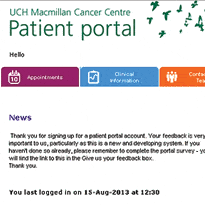Patients go through the portal at UCLH
- 16 August 2013

Around 250 cancer patients at a London trust are using an in-house portal to check appointments, view clinic letters and communicate with their clinicians.
University College London Hospitals NHS Foundation Trust built its own patient portal, which has been in use for more than a year.
Haematology general manager Emily Collins told EHI the portal is primarily used as a secure communication channel between patients and trust stuff and for patients to check their appointments.
An administrative co-ordinator checks for messages sent by patients twice a day and can deal with routine questions themselves or assign the query for the attention of a care team. Patients can identify how urgently they need a response.
“The messaging system interfaces directly with the clinical system used centrally, that means that any dialogue staff have with patients becomes part of their care record,” Collins said.
Portal users can see their care information and a selection of clinical documents such as discharge summaries and clinic letters. They can also find links to websites related to their condition.
Around 250 patients are registered to use the portal and they can nominate a family member or carer to have access.
It also functions as a way of gathering patient feedback. The trust is piloting a “distress thermometer” for monitoring how unwell a patient is feeling in the days or weeks before their appointment, providing data that their clinician can review.
Extra functionality is also being built to allow patients to see certain test results, however the issue of safeguards around this is still being talked through.
Collins said the portal is only for use by patients treated in the cancer centre, but there are talks about rolling it out more widely.
She said staff were previously communicating with patients via email that was not completely secure.
Also, if a staff member had an email conversation with a patient, this would not necessarily be communicated to the rest of their care team.
The portal project started with a broad survey of patients asking what they would find helpful. A small group of patients then worked with the trust to design the portal alongside clinical teams.
The key things patients wanted was secure communication and access to their appointments.
Nurse assistant Jordan Rapaport started using the portal with patients about a year ago.
“It allows us to manage our workload and patients can see their appointments which stops them ringing up to ask and we are not missing messages because everything can be accessed by all members of the team,” he said.
“It provides an electronic trail that is really useful in terms of providing continuity of care.”
A group of volunteers help patients to log on for the first time and use the portal.
Collins said feedback has been very positive and patients are now pushing for more functionality.





